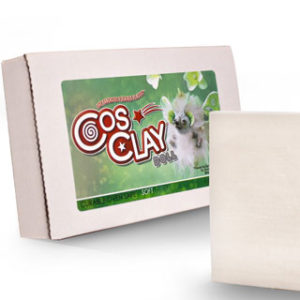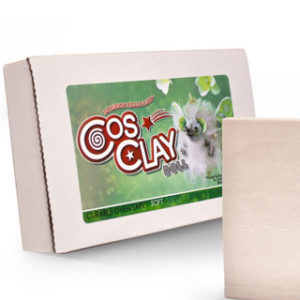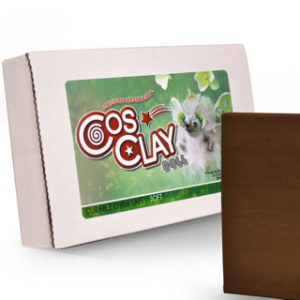Sculpting
-
-
-
Cosclay Doll – Beaut Brown
We are delighted to be a dealer for this wonderful new product Cosclay. We are anticipating receiving our first shipment approximately end of October.
Indulge your fantasies in the enchanting wonder of Cosclay® DOLL. This specially formulated soft blend is designed for Doll Makers and OOAKs alike. As with all Cosclay grades, our DOLL line has high green strength, blends with ease, will not sag in the oven and has minimal color shift.
Cosclay DOLL is currently available in four colors: Faerie Light, Angelic Rose Lite, Warm Beige and Beaut Brown.
“Flower Butterfly Hedgehog” by Svetlana Matveeva
FAQ’s:
What is Cosclay?
Cosclay is a hybrid, plastic/rubber polymer clay that will remain strong and flexible after curing. Unlike other polymer clays, Cosclays’ unique flexibility imparts a durable and resilient quality that is suitable for endless applications, such as stop-motion characters, posable figures, one of a kind (OOAK) sculptures and much more! Cosclay allows for the creation of very thin and delicate pieces without the fear of breakage after curing, especially during transit. The possibilities are limited only by your imagination. What will you make?
What can I do with my Cosclay creation once I am finished with it?
You can reuse Cosclay to make something else while in clay form or you can bake your piece to permanently lock in the creation you made.
How thin can I make Cosclay?
You can a make it as thin or as thick as you want. The thinner the piece, the more rubbery it will cure and the thicker you make it the more like plastic it will be.
Can Cosclay be sanded or polished?
Yes it can, but because of its flexibility there is more surface drag than a rigid piece. Therefore, we recommend using a wet sanding technique to reduce surface drag. It takes some effort, but Cosclay can be sanded and ground down with Dremel motor tools and cut with various precision hand tools.
Once you’re satisfied with your creation, you can bake it in a home oven to convert it from its malleable form to a permanently flexible solid rubber/plastic. To do this, it is important to set your oven at the correct temperature and check that it is correct by using a secondary oven safe thermometer.
What temperature is best to cure Cosclay to get the optimal properties of the cured clay?
It is important to cure at 275°F for at least 30 minutes per ¼” of material. If Cosclay is cured at too low a temperature, it will have a weak cure and will break when bent instead of flexing and holding its shape. Because Cosclay is temperature sensitive we do not recommend tabletop plastic dome style halogen convection ovens. Or small tabletop toaster ovens. We find that these types of ovens generate hotspots and uneven heating. While they may work for conventional polymer clays, they do not work well for Cosclay. The best type oven that provides the most even heating is a conventional home oven, either electric or gas.
I noticed that sometimes when curing my creation that there is some steam that is made during baking. Is the steam hazardous to breath?
The steam is not considered hazardous, but should be ventilated for good measure. Cosclay is made from all non-toxic ingredients. If you experience excess steam, it is likely that you are baking the clay at too high a temperature. Check your oven with a secondary thermometer to make sure it is baking at the correct temperature. Be sure not to burn the clay and keep it safely away from all heating elements. Cosclay is a professional medium and is not intended for use by children and should be used only under the supervision of an adult. Larger pieces will sometimes generate more steam because there is a greater mass of material to cure.
To reduce costs and use less material, we recommend using aluminum armature wire over a tin foil core. We do not recommend using any kind of colored, plastic tape or masking tape over the foil as colors can transfer and bleed into your clay and ruin the coloration. This may be especially apparent with lighter colored clays.
What is the best material to cover my tin foil shape to secure it in place before I begin my sculpture?
The best material to use is an aluminum foil tape available at most hardware stores. This kind of tape is used primarily for sealing metal duct work and has a metal coating on one side and a specialty adhesive tape on the other side. Be sure not to confuse this type of tape with regular gray or colored duct/duck tape which will melt in the oven. Metal foil tapes are heat resistant.
I notice that when I make parts like limbs over a wire armature that Cosclay does not seem to adhere to the metal. When I flex my piece over the wire, I can feel the clay slide over the wire. How can I prevent this from happening?
One of the best and easiest ways to prevent this is to wrap a thinner wire around the primary wire to give the cured clay to more of an irregular surface to keep it in place. Another method is to add some thin layer of epoxy clay over the foil shell. Cosclay tends to stick better to epoxy than metal.
I notice that my Cosclay cracked in spots after I baked it. Why did this happen?
There are a couple of reasons that this could have happened. First, you may have used a very thick section of clay and overheated it. When Cosclay gets overheated, it generates a steam that is trying to escape from the clay body. The easiest way for the steam to release is to rapidly push its way out by generating a crack for easy escape in the not fully cured clay.
The second reason for cracks after baking is caused by baking your piece once and then reposing it and baking again. When you do this, you are generating tension in the armature. Cosclay has a memory so when you bake it again, it softens and the areas that are bent put force on the new position and a crack will form wherever the new bend comes through. To avoid this problem, do not re-position your piece until after the final bake.
Can I bake my Cosclay, add new Cosclay and bake it again? Will the new clay stick to the cure clay?
The answer is yes! You can bake Cosclay repeatedly and new clay will stick to cured clay.
How many times can I bake my piece without losing the flexible aspect of Cosclay?
Cosclay is formulated to remain flexible after repeated baking. We have baked pieces dozens of times without any noticeable loss of flexibility.
How long will Cosclay last in its original container?
Sealed in its original packaging, Cosclay can last many years. Once opened Cosclay still has no specific expiration date as long as it is kept in a closed container. Exposure to air can cause a slow reaction (depending on the degree of humidity) that can result in slight drying. The drying effect can easily be corrected by kneading the clay and storing in a closed container.
Can Cosclay be painted?
Yes. Cosclay can be painted with acrylics, pastels, Genesis polymer paints and some urethanes.
Does Cosclay contain any hazardous components?
No. Cosclay is made of 100% nontoxic ingredients. It has been tested by a certified toxicologist and conforms to ASTM D-4236. Cosclay contains no hazardous ingredients.
Are any of Cosclays ingredients tested on Animals?
No. The polymers that cause Cosclay to cure are all made of plastic and rubber. None of the polymers are tested on animals and all of the remaining ingredients are derived from earth minerals and plants. There are no animal byproducts used to make Cosclay either.
Could Cosclay be considered a vegan friendly product?
In the sense that it contains no animal products or animal byproducts, the answer is yes.
How many Colors does Cosclay come in?
Currently, we offer 13 colors but we expect new colors to be introduced in the near future.
Will different firmnesses be introduced in the future?
Yes. We expect to be making a softer grade that has been requested by many. The current grade is considered medium firm but the skin tones are slightly softer. We will soon be reintroducing the skin tones in a new softer grade.
When will Cosclay be released to the general public?
Cosclay will be available for purchase online and at select brick and mortar locations. Our rollout will begin in the late Spring of 2020. If you would like to purchase Cosclay from your preferred vendor, please let your vendor know that you would like them to carry Cosclay. There is a good chance that they will!
Can Cosclay be used to create traditional polymer clay techniques?
Yes. Caning, Mokume-gane and other traditional techniques can be done very effectively with Cosclay.
What is a fast way to condition Cosclay?
Cosclay blocks can be chopped up and added to small food processors like the Cuisinart Mini Prep. The friction of the food processor will warm the clay and soften it quickly. The resulting warm material can be placed in a pasta machine to make various sheet sizes for use in your creations. Or you can just use a pasta machine. Here are the links to both items:
$15.95Cosclay Doll – Beaut Brown
$15.95




